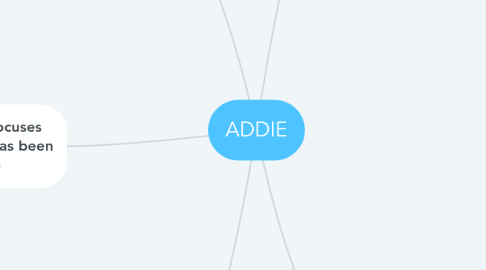
1. Develop - This phase is where the actual course material is created
1.1. Develop the Training Program
1.1.1. Create a Prototype
1.1.1.1. Demonstrate the general concept of the course /Training program to the Stakeholders
1.1.1.1.1. Seek approval for the go ahead for course development
1.1.1.2. Provide a summary course plan to the Stakeholders for reveiw
1.1.1.3. Conduct a test run
1.1.1.3.1. Have learners test prototype and record their feedback. Make changes where necessary and retest.
1.1.2. Develop the course
1.1.2.1. Develop interactive and engaging training program utilizing multimedia elements such as graphs, videos , tables etc.
1.1.2.1.1. Produce courseware utilizing Authoring tools such as Articulate 360 , Lectora or Adobe Captivate. Authoring Software to be determined in the Design Phase.
1.1.2.1.2. Work with Quality Assurance and Quality Control professionals to ensure content is free from errors , misspellings or operating issues.
1.2. Review the processes, make the adjustments if necessary
2. Implement - This phase focuses on the delivery of what has been designed for the learners
2.1. Target Audience interaction with the Course
2.1.1. Format of Course
2.1.1.1. Classroom instructions
2.1.1.1.1. Provision of scripts and facilitator guides for trainers. Feedback forms - handouts for learners
2.1.1.2. Synchronous-Virtual classrooms or virtual meetings
2.1.1.2.1. Utilize chat and online surveys for learners to provide feedback
2.1.1.3. Asynchronous - Self paced, online course /courseware
2.1.1.3.1. Provide online feedback forms for the learners
2.2. Review the processes, make the adjustments if necessary
3. Evaluate - This phase measures the effectiveness of the training
3.1. Conduct a Formative Evaluation
3.1.1. Conduct one-to-one evaluation
3.1.1.1. Provides Clarity, Usefulness and Relevancy
3.1.2. Small group evaluation
3.1.2.1. Determines how well the activities provided in the course works with small groups
3.1.2.1.1. Questions to be asked ? - 1. Do you understand the goal and objectives of the course?
3.1.2.1.2. 2 Were the practical exercises limited?
3.1.2.1.3. 3. Was there enough feedback?
3.1.2.1.4. 4. Was the course fun and engaging
3.1.3. Field Trial
3.1.3.1. A Field trial to be conducted as close to an actual field environment to evaluate the efficacy of learning under specific conditions and a specific environment
3.2. Conduct a Summative Evaluation
3.2.1. Application of KirkPatrick's Evaluation
3.2.1.1. 1. Reaction
3.2.1.1.1. Smile sheets distributed, Provide immediate feedback
3.2.1.2. 2.Learning
3.2.1.2.1. Assessment of knowledge gained during the training
3.2.1.3. 3.Behaviour
3.2.1.3.1. Application of skills and knowledge learned from training
3.2.1.4. 4.Results
3.2.1.4.1. Measurement of performance and the effects it has on the organization
3.3. Review feedback from learners. Make the necessary improvements and adjustments. Implement a Continuous Improvement cycle program.
4. Analyze - This phase is the where the training needs are determined for the learner
4.1. Instructional Analysis
4.1.1. Processes to determine the training needs of the users in the organization
4.1.1.1. Conduct Task Analysis and Performance Analysis of the learners
4.2. Audience Analysis
4.2.1. Learner - Experience, Age, Biases , Prior Knowledge.
4.2.1.1. Questions to ask- Who is the course being designed for?
4.2.1.2. How will the learners apply the skills learned to their jobs?
4.2.1.3. Are the learners computer literate and at what level?
4.2.1.4. What are the learners expectation from the training program?
4.3. Organizational Goals & Learning Objectives
4.3.1. Behavioral and Performance Goals - Expected change in learner behaviour and performance after completion of the training program. This should relate directly to the learner's job role and should help to improve their performance.
4.3.1.1. Questions to ask- What new skills and knowledge do we want the learners to learn after completion of the training?
4.3.1.2. What organizational goal will be achieved at the end of the training?
4.4. Logistics
4.4.1. Budget, Timeline, Learning Evironment
4.4.1.1. Questions to ask- Is there a budget assigned and approved for the training project?
4.4.1.2. What is the date planned for the launch of the training program?
4.4.1.3. Where will the training be delivered ? (Learning Environment)
4.5. Review the processes make the necessary adjustments if needed.
5. Design - The design phase is where the content of the training is determined
5.1. Delivery of the Training
5.1.1. Determine how the training will be delivered
5.1.1.1. Types of Training
5.1.1.1.1. Web based training (WBT)
5.1.1.1.2. Face 2 Face
5.1.1.1.3. Self paced
5.1.1.1.4. Classroom Instruction
5.1.1.1.5. Blended Learning
5.1.1.1.6. Micro-Learning
5.1.2. Determine authoring tool to be used - Lectora, Articulate 360 or Adobe Captivate
5.2. Learning Objectives
5.2.1. State learning objectives for the different modules presented
5.2.2. User Interaction with the training program
5.2.2.1. Assessments and exercises
5.2.2.2. Scenarios
5.2.2.3. Role playing
5.3. StoryBoard
5.3.1. Design and drafting of the Storyboard
5.3.1.1. Seek approval from Stakeholders
5.3.2. Design of user interface
5.4. Instructional Strategy
5.4.1. Creation of the design strategy document
5.4.1.1. Document should include the following components:
5.4.1.1.1. Technical Training Scope
5.4.1.1.2. Design Challenges and assumptions
5.4.1.1.3. The Course Structure
5.4.1.1.4. The Course Context
